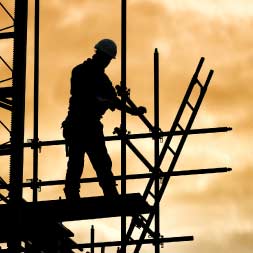The
Construction Industry is the most booming Sector in India and requires safety
assistance at best. The construction industry, employing the largest labor
force in the country has accounted for about 11% of all occupational injuries
and 20% of all deaths resulting from occupational accidents and the cost of
accidents is very expensive. Unfortunately, it is also the most vulnerable
segment of unorganized Labor force being exposed to health hazards and
high-risk environment. TheSafetyMaster™
TheSafetyMasterTM,
Global leader in Industrial Safety Management conducts the Construction Safety
Audit -
-Hazards
Identify and control
-Training,
communication, documentation and enforcement of safety rules
-Monitor
and maintenance of safe working conditions
-Reviewing
circumstances involved in incidents
Our
Safety Professionals are trained exclusively to handle and identify any
potential threat to your Organization. We evaluate the currently employed
methods of Safety & health; motivate the Client to adhere to the latest
standards of NSC in Health, Safety and Environment risks of Construction
Workers.
TheSafetyMasterTM
have been conducting Training Programs, Workshops, Safety Audits, Information
dissemination, producing awareness material and organizing awareness Campaigns
about risks attached to Construction Industry and their remedy.
Our
Safety Audits, conducted by the Safety Experts having years of experience over
respective Fields.
Our Methodology
ü Writing safety manuals
ü Preparing safety checklists
ü And detailed inspection report
ü Checking of Work Permits, preparation
of disaster management plan
ü Check on methods of Contractor
selection and safety
ü Check on personal protective equipment
ü Propagation, Implementation and
monitoring of all laws and regulation OHS Policy
ü Training and practical guidance for Internal
& External work
ü Strategic planning to achieve the
highest level of the safety standard for coming years, analysis of past
accidental reports and deployment of all the necessary elements to work
safely
ü Inspection and verification of each
& every element of Technical and HSE Management at the worksite e.g. Safety
equipment, human intelligence and credibility, proper training, uncontrolled
elements etc.
Health
and safety is one of the most important considerations you should take before
any construction project gets underway. You should always make sure that all
aspects of health and safety have been considered before you step foot on the
construction site. Health and safety in construction are particularly important
because the industry is prone to hazardous situations and can be dangerous at
times.
Our
practical and professional approach helps Organizations to understand the
Safety Norms and stick to them entirely. Thus saving Penalties, Fines and Legal
Hassles.
We are proud to offer our services in-
Construction
Safety Audit
Construction Safety Manual
HIRA
Excavation
Training
Safety Trainings
Pemit to Work
Work at Height/Material Handling
Safety Trainings
Site Safety Staff
BBS Training
Heavy Equipment Training
Scaffolding Training
Project Safety Plan
Project Safety Manual
Send
us your enquiry to info@thesafetymaster.com
or speak to our expert at +917665231743 for getting above services today to
achieve safety goals.














